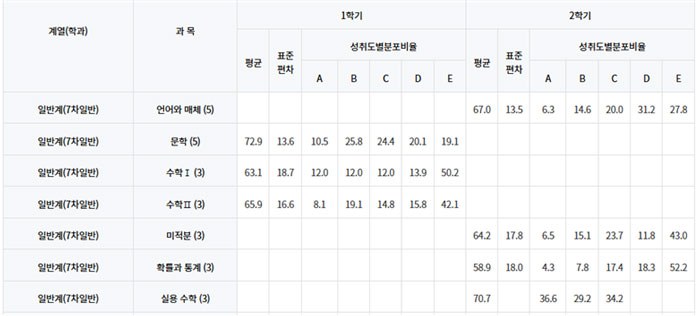전국중등수석교사회 회장 권 혁 선
수포자 방지와 책임교육을 위해 고교 학점제가 꼭!!! 필요한 이유
최근 교육 현장에서 가장 큰 화두는 "학력 저하"다. 이 말은 단순히 성적이 낮다는 뜻을 넘어서, 공교육의 신뢰와 기능이 흔들리고 있다는 우려를 담고 있다. 특히 수학에서의 학력 저하는 "수포자"(수학 포기자)의 증가와 밀접하게 연결되어 있다. 수포자가 많다는 것은 수학 수업을 따라가지 못하는 학생이 많다는 뜻이며, 이는 교실 내 학력 격차가 심각하다는 신호이기도 하다.
2024년 국가수준 학업성취도 평가 결과에 따르면, 고2 학생 중 기초학력 미달 비율은 국어(8.6%)와 수학(16.6%)에서 모두 증가했다. 수학에서 특히 심각하다는 것이 확인된다. 이러한 현상을 줄이기 위한 다양한 방법들이 제시됐지만, 아직 뚜렷한 성과는 없다. 그렇다면 정말 필요한 해법은 무엇일까?
정답은 "교육과정의 편성 방식"에 있다. 어떤 과목을, 어떻게 가르치느냐에 따라 학생들의 학업성취도는 크게 달라질 수 있다.
전북의 수학 성취도, 왜 낮을까?

종로학원이 발표한 자료에 따르면, 전북지역 고등학생의 수학 A등급 비율은 단 7.7%로 전국 최하위다. 전국 평균(16.5%)의 절반 수준에 불과하다. 이처럼 낮은 성취도의 원인은 크게 두 가지로 분석된다.
하나는 과도하게 위계 높은 과목들을 모두 학생에게 의무 수강하게 하는 교육과정 운영이다. 다른 하나는 이러한 운영방식이 내신 경쟁을 위한 상대평가, 정시 중심의 교육과정과 맞물려 학생들에게 지나친 부담을 주고 있다는 점이다.
A학교 사례: 빠른 진도, 많은 수포자

A학교는 수학I과 수학II를 모두 의무로, 한 학기에 3단위씩 빠르게 진행했다. 본래 5단위로 설계된 과목을 3단위로 축소하면서 진도는 빨랐고, 선행학습을 한 일부 학생만이 수업을 주도했다. 나머지 학생들은 수업을 따라가지 못하고 수포자가 되었거나 사교육에 의존하게 되었을 가능성이 크다.
수학I 평균: 65점
A수준(90점 이상): 12.0%
E수준(60점 이하): 50.2%
수학II 평균: 64점
A수준: 8.1%
E수준: 42.1%
2학기의 확률과 통계 성적은 더 심각하다. 평균은 58.9점이고, A수준은 4.3%, E수준은 52.2%로 절반 이상이 기초 미달이다.
이처럼 높은 학업 격차는, 과목 선택권이 제한되고, 수학 실력이 낮은 학생에게도 위계 높은 과목을 강제로 수강하게 했기 때문에 발생한 결과다.
내신 경쟁? 학점제와 절대평가가 해법

이러한 교육과정 편성에 대해 현장 교사들은 "수강 인원이 줄어들면 내신 경쟁이 심해질 수 있다"는 우려를 한다. 그래서 수학을 필수로 지정하고, 선택권 없이 모든 학생에게 동일한 과목을 수강하게 한다. 하지만 이 방식이야말로 수포자를 대량으로 양산하는 주요 원인이다.
이를 해결하기 위해서는 절대평가와 성취평가 중심의 고교학점제가 필요하다. 고교학점제는 학생의 학업 수준과 진로에 맞춘 과목 선택을 보장하며, 수업을 포기하지 않고 자신에게 맞는 수준의 학습을 할 수 있도록 해준다.
B학교 사례: 선택권 보장, 성취도 향상

B학교는 2학년 1학기에 수학I만을 편성하고, 수학II는 2학기, 확률과 통계는 3학년으로 분산했다. 또한 수학과제탐구나 확률과 통계를 여러 차례 선택할 수 있도록 유연하게 운영했다.
수학I 평균: 65.1점
A수준: 35.6%
E수준: 13.1%
수학II 평균: 65.0점
A수준: 32.5%
E수준: 17.3%
확률과 통계도 2학년과 3학년으로 나누어 편성했다. 수학과제탐구도 마찬가지다. 계열별 학습 수준 차이를 고려한 결과로, 1학기 수학과제탐구 평균은 92.4점, 2학기는 84.9점으로 나타났다.
이러한 교육과정은 학생의 선택권을 존중하고, 각자에게 맞는 학습 기회를 제공함으로써 학업 성취도를 높이는 데 효과적이었다. 내신 부담을 줄이면서도, 학생의 역량에 따라 창의적인 탐구활동이 가능했다.
고교학점제는 선택이 아니라 필수
수학 성취도 격차를 줄이고 수포자를 예방하기 위해서는 학생의 수준과 진로에 맞춘 교과 선택이 가능해야 한다. 이를 실현할 수 있는 유일한 방법이 고교학점제다.
책임교육을 실현하고 학업 미달 학생에 대한 최소성취를 보장하려면, 학생중심 교육과정이 우선되어야 한다. 단순한 성적 분포를 넘어, 깊이 있는 탐구학습과 개념 중심 학습이 가능해지는 전제 조건은 교육과정의 편성 방식에 달려 있다.
수포자를 줄이고, 모든 학생에게 의미 있는 수업을 제공하기 위해서는 지금 바로, 고교학점제를 제대로 시행해야 한다.






